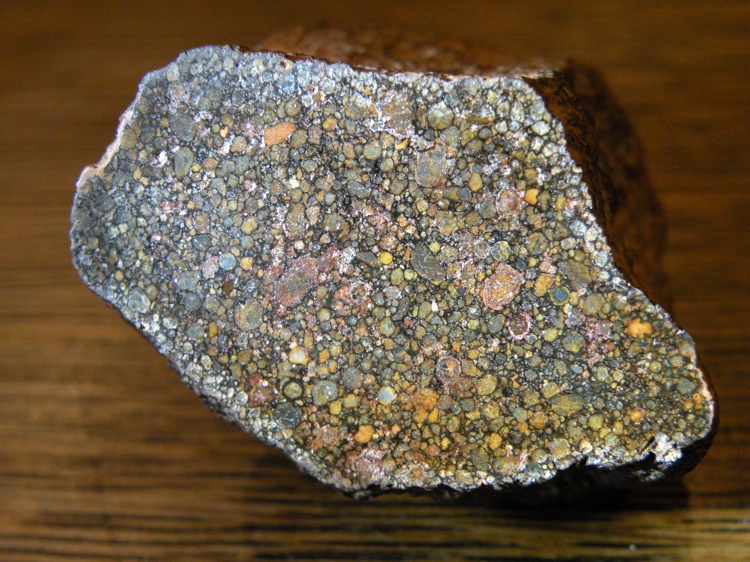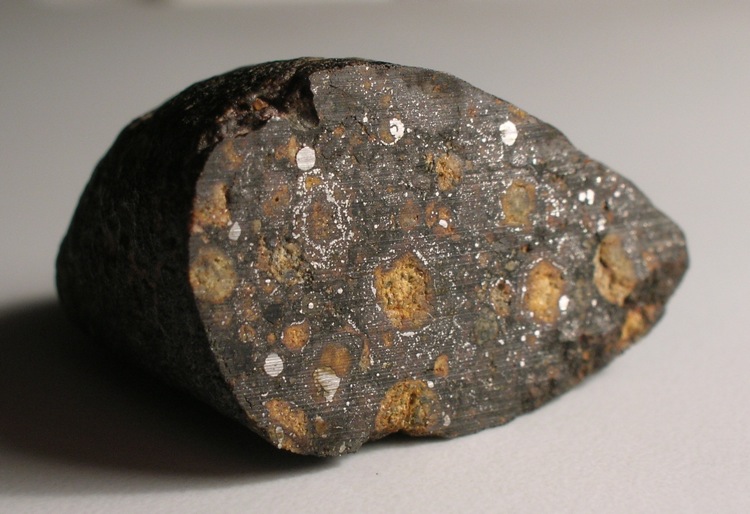 | | | Collecting and preserving meteorites since 1998. |
| |
|  |
|
|  |
Chondrites are the most primitive group of meteorites. They have formation ages dating to at least 4.5 billion years before the present and have been little altered since then. They are called chondrites because they contain structures called chondrules: small, spherical droplets of rock that condensed in the solar nebula via still-debated and little-understood processes.
"Ordinary" chondrites are more common than most others, and include H, L, LL, and HH chondrites. It's important to remember that they include some of the least altered types of meteorites.

The 85 gram main mass of NWA 6509, an unequilibrated "ordinary" chondrite recently classified as an L3.6.
Carbonaceous chondrites are the most-studied meteorites because they often contain complex organic molecules -- necessary for the formation of life. It has been hypothesized that these meteorites may have 'seeded' earth with the compounds required to create the most primitive organisms.

The ~5 gram main mass of a fresh new CR2 from Northwest Africa.
Other types of chondrites unclude R, CH, CB, K, and a few others.
Current science suggests that these off chondrites are samples from different parent bodies -- rocks that formed in different regions of the solar system, as they are chemically and/or isotopically distinct from other meteorites. These account for no more than a percent or two of all recovered meteorites and are extremely rare and of relatively high scientific importance.
Chondrite nomenclature is pretty easy to understand once you get the hang of it.
The first letter(s) in the classification denote a group of meteorites deemed distinct by chemical differences. The number following the letter(s) determines the nature and amount of alteration that the meteorite has undergone since its chondrules first solidified.
A type-3.0 chondrite would be essentially unchanged since forming. The higher the number (3.0 to 6), the more (re)melted the chondrules get, until you can't see them anymore. Past 6 or 7 (it's debated as to whether type-7 chondrites are a legitimate thing), you wouldn't be able to see the chondrules anymore and you would have a primitive achondrite.
If the number is less than a 3, the meteorite wasn't heated/melted, but was instead altered by the presence of water into clay minerals (likely at temperatures at which liquid or frozen water would be stable). Some type 1 and 2 meteorites have *never* been heated above ~150°C since forming. That's 4.557 billion years of cold storage in some cases.
In other words:
altered by water into clay
1 - nearly complete alteration into clays, chondrules rare
2 - slight alteration into clays, esp. at mineral margins
3 - unaltered
4 - a little remelted
5 - chondrules getting fuzzy
6/7 - chondrules almost entirely recrystallized, hard to recognize
recrystallized via heat, no recognizeable chondrules
It should be noted that many meteorites are simply classified as type-3's, in which case we laymen don't know whether the meteorite in question is a 3.01 (really primitive!) or a 3.9 (less primitive). Type "3" stones can be anything in that range.
A larger stone: the ~28 kilogram oriented main mass of Bunker Hill, from Kansas.

While the classification of the above stone is nothing too special (L6), it is one of the larger American meteorites found in the past several years lucky enough to escape the saw.
If you have any questions or suggestions for the content of this page, please let me know via email. Thanks!
|
| | |
|
